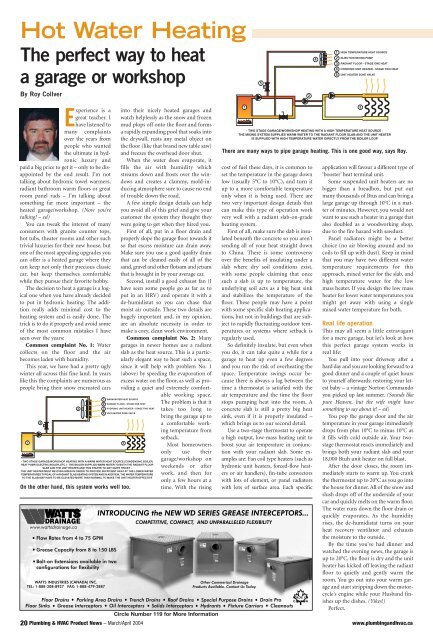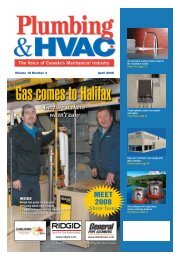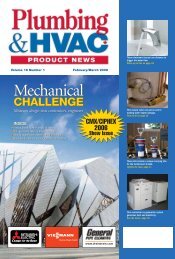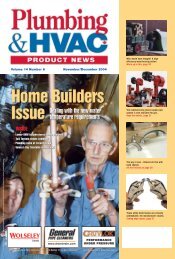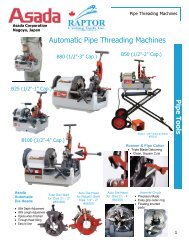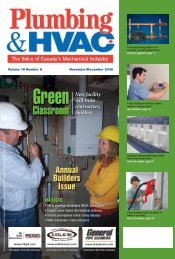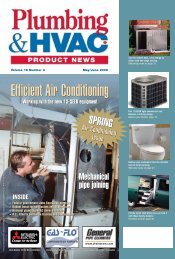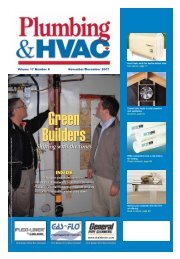CMX 2004 - Plumbing & HVAC
CMX 2004 - Plumbing & HVAC
CMX 2004 - Plumbing & HVAC
You also want an ePaper? Increase the reach of your titles
YUMPU automatically turns print PDFs into web optimized ePapers that Google loves.
Hot Water Heating<br />
The perfect way to heat<br />
a garage or workshop<br />
By Roy Collver<br />
5<br />
M<br />
2<br />
4<br />
1<br />
2<br />
3<br />
4<br />
5<br />
HIGH TEMPERATURE HEAT SOURCE<br />
INJECTION MIXING PUMP<br />
RADIANT FLOOR - STAGE ONE HEAT<br />
HYDRONIC UNIT HEATER - STAGE TWO HEAT<br />
UNIT HEATER ZONE VALVE<br />
Experience is a<br />
great teacher. I<br />
have listened to<br />
many complaints<br />
over the years from<br />
people who wanted<br />
the ultimate in hydronic<br />
luxury and<br />
paid a big price to get it – only to be disappointed<br />
by the end result. I’m not<br />
talking about hydronic towel warmers,<br />
radiant bathroom warm floors or great<br />
room panel rads – I’m talking about<br />
something far more important – the<br />
heated garage/workshop. (Now you’re<br />
talking! – ed)<br />
You can tweak the interest of many<br />
consumers with granite counter tops,<br />
hot tubs, theater rooms and other such<br />
trivial luxuries for their new house, but<br />
one of the most appealing upgrades you<br />
can offer is a heated garage where they<br />
can keep not only their precious classic<br />
car, but keep themselves comfortable<br />
while they pursue their favorite hobby.<br />
The decision to heat a garage is a logical<br />
one when you have already decided<br />
to put in hydronic heating. The addition<br />
really adds minimal cost to the<br />
heating system and is easily done. The<br />
trick is to do it properly and avoid some<br />
of the most common mistakes I have<br />
seen over the years:<br />
Common complaint No. 1: Water<br />
collects on the floor and the air<br />
becomes laden with humidity.<br />
This year, we have had a pretty ugly<br />
winter all across this fine land. In years<br />
like this the complaints are numerous as<br />
people bring their snow encrusted cars<br />
cost of fuel these days, it is common to<br />
set the temperature in the garage down<br />
low (usually 5°C to 10°C), and turn it<br />
up to a more comfortable temperature<br />
only when it is being used. There are<br />
two very important design details that<br />
can make this type of operation work<br />
very well with a radiant slab-on-grade<br />
heating system.<br />
First of all, make sure the slab is insulated<br />
beneath the concrete so you aren’t<br />
sending all of your heat straight down<br />
to China. There is some controversy<br />
over the benefits of insulating under a<br />
slab where dry soil conditions exist,<br />
with some people claiming that once<br />
such a slab is up to temperature, the<br />
underlying soil acts as a big heat sink<br />
and stabilizes the temperature of the<br />
floor. These people may have a point<br />
with some specific slab heating applications,<br />
but not in buildings that are subject<br />
to rapidly fluctuating outdoor temperatures<br />
or systems where setback is<br />
regularly used.<br />
So definitely insulate, but even when<br />
you do, it can take quite a while for a<br />
garage to heat up even a few degrees<br />
and you run the risk of overheating the<br />
space. Temperature swings occur because<br />
there is always a lag between the<br />
time a thermostat is satisfied with the<br />
air temperature and the time the floor<br />
stops pumping heat into the room. A<br />
concrete slab is still a pretty big heat<br />
sink, even if it is properly insulated –<br />
which brings us to our second detail.<br />
Use a two-stage thermostat to operate<br />
a high output, low-mass heating unit to<br />
boost your air temperature in conjunction<br />
with your radiant slab. Some examples<br />
are: Fan coil type heaters (such as<br />
hydronic unit heaters, forced-flow heaters<br />
or air handlers), fin-tube convectors<br />
with lots of element, or panel radiators<br />
with lots of surface area. Each specific<br />
application will favour a different type of<br />
‘booster’ heat terminal unit.<br />
Some suspended unit heaters are no<br />
bigger than a breadbox, but put out<br />
many thousands of Btus and can bring a<br />
large garage up through 10°C in a matter<br />
of minutes. However, you would not<br />
want to use such a heater in a garage that<br />
also doubled as a woodworking shop,<br />
due to the fire hazard with sawdust.<br />
Panel radiators might be a better<br />
choice (no air blowing around and no<br />
coils to fill up with dust). Keep in mind<br />
that you may have two different water<br />
temperature requirements for this<br />
approach, mixed water for the slab, and<br />
high temperature water for the low<br />
mass heater. If you design the low mass<br />
heater for lower water temperatures you<br />
might get away with using a single<br />
mixed water temperature for both.<br />
into their nicely heated garages and<br />
watch helplessly as the snow and frozen<br />
mud plops off onto the floor and forms<br />
a rapidly expanding pool that soaks into<br />
the drywall, rusts any metal object on<br />
the floor (like that brand new table saw)<br />
and freezes the overhead door shut.<br />
When the water does evaporate, it<br />
fills the air with humidity which<br />
streams down and frosts over the windows<br />
and creates a clammy, mold-inducing<br />
atmosphere sure to cause no end<br />
of trouble down the road.<br />
A few simple design details can help<br />
you avoid all of this grief and give your<br />
customer the system they thought they<br />
were going to get when they hired you.<br />
First of all, put in a floor drain and<br />
properly slope the garage floor towards it<br />
so that excess moisture can drain away.<br />
Make sure you use a good quality drain<br />
that can be cleaned easily of all of the<br />
sand, gravel and other flotsam and jetsam<br />
that is brought in by your average car.<br />
Second, install a good exhaust fan (I<br />
have seen some people go as far as to<br />
put in an HRV) and operate it with a<br />
de-humidistat so you can chase that<br />
moist air outside. These two details are<br />
hugely important and, in my opinion,<br />
are an absolute necessity in order to<br />
make a cozy, clean work environment.<br />
Common complaint No. 2: Many<br />
garages in newer homes use a radiant<br />
slab as the heat source. This is a particularly<br />
elegant way to heat such a space,<br />
since it will help with problem No. 1<br />
(above) by speeding the evaporation of<br />
excess water on the floor, as well as providing<br />
a quiet and extremely comfort-<br />
Real life operation<br />
This may all seem a little extravagant<br />
for a mere garage, but let’s look at how<br />
this perfect garage system works in<br />
real life:<br />
You pull into your driveway after a<br />
hard day and you are looking forward to a<br />
good dinner and a couple of quiet hours<br />
to yourself afterwards: restoring your latest<br />
baby – a vintage Norton Commando<br />
able working space.<br />
you picked up last summer. (Sounds like<br />
1 WARM WATER HEAT SOURCE<br />
2 RADIANT FLOOR - STAGE ONE HEAT<br />
The problem is that it<br />
pure Heaven, but the wife might have<br />
3<br />
3 HYDRONIC UNIT HEATER - STAGE TWO HEAT<br />
takes too long to<br />
something to say about it! – ed)<br />
4 UNIT HEATER ZONE VALVE<br />
bring the garage up to<br />
You pop the garage door and the air<br />
4<br />
a comfortable working<br />
temperature from<br />
drops from plus 10°C to minus 10°C as<br />
temperature in your garage immediately<br />
M<br />
setback.<br />
it fills with cold outside air. Your twostage<br />
thermostat reacts immediately and<br />
1<br />
2<br />
Most homeowners<br />
only use their<br />
brings both your radiant slab and your<br />
garage/workshop on<br />
18,000 Btuh unit heater on full blast.<br />
- TWO STAGE GARAGE/WORKSHOP HEATING WITH A WARM WATER HEAT SOURCE (CONDENSING BOILER,<br />
HEAT PUMP, ELECTRIC BOILER, ETC.) - THE BOILER SUPPLIES WARM WATER TO BOTH THE RADIANT FLOOR<br />
SLAB AND THE UNIT HEATER AND THIS STARTS TO GET QUITE TRICKY -<br />
weekends or after<br />
After the door closes, the room immediately<br />
starts to warm up. You crank<br />
THE UNIT HEATER MUST BE OVER-SIZED IN ORDER TO PROVIDE SUFFICIENT HEAT AT THE LOWER WATER<br />
TEMPERATURES TYPICAL OF A RADIANT SLAB HEATING SYSTEM AND IN ADDITION, THE WATER TEMPERATURE work, and then for<br />
TO THE SLAB MAY HAVE TO BE ELEVATED MORE THAN NORMAL TO MAKE THE UNIT HEATER EFFECTIVE<br />
only a few hours at a<br />
the thermostat up to 20°C as you go into<br />
On the other hand, this system works well too.<br />
time. With the rising<br />
the house for dinner. All of the snow and<br />
slush drops off of the underside of your<br />
car and quickly melts on the warm floor.<br />
The water runs down the floor drain or<br />
INTRODUCING the NEW WD SERIES GREASE INTERCEPTORS... quickly evaporates. As the humidity<br />
COMPETITIVE, COMPACT, AND UNPARALLELED FLEXIBILITY<br />
rises, the de-humidistat turns on your<br />
www.wattsdrainage.ca<br />
heat recovery ventilator and exhausts<br />
Flow Rates from 4 to 75 GPM<br />
the moisture to the outside.<br />
By the time you’ve had dinner and<br />
Grease Capacity from 8 to 150 LBS<br />
watched the evening news, the garage is<br />
up to 20°C, the floor is dry and the unit<br />
Bolt-on Extensions available in two<br />
configurations for flexibility<br />
heater has kicked off leaving the radiant<br />
floor to quietly and gently warm the<br />
room. You go out into your warm garage<br />
and start stripping down the motor-<br />
WATTS INDUSTRIES (CANADA) INC.<br />
Other Commerical Drainage<br />
TEL: 1-888-208-8927 FAX: 1-888-479-2887<br />
Products Available. Contact Us Today.<br />
cycle’s engine while your Husband finishes<br />
up the dishes. (Yikes!)<br />
MADE IN<br />
Floor Drains Parking Area Drains Trench Drains Roof Drains Special Purpose Drains Drain Pro CANADA<br />
Floor Sinks Grease Interceptors Oil Interceptors Solids Interceptors Hydrants Fixture Carriers Cleanouts<br />
Perfect.<br />
Circle Number 119 for More Information<br />
20 <strong>Plumbing</strong> & <strong>HVAC</strong> Product News – March/April <strong>2004</strong> www.plumbingandhvac.ca<br />
1<br />
- TWO STAGE GARAGE/WORKSHOP HEATING WITH A HIGH TEMPERATURE HEAT SOURCE -<br />
THE MIXING SYSTEM SUPPLIES WARM WATER TO THE RADIANT FLOOR SLAB AND THE UNIT HEATER<br />
IS SUPPLIED WITH HIGH TEMPERATURE WATER DIRECTLY FROM THE BOILER LOOP<br />
There are many ways to pipe garage heating. This is one good way, says Roy.<br />
3


